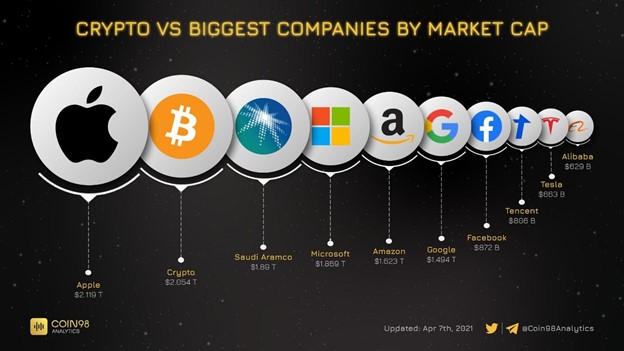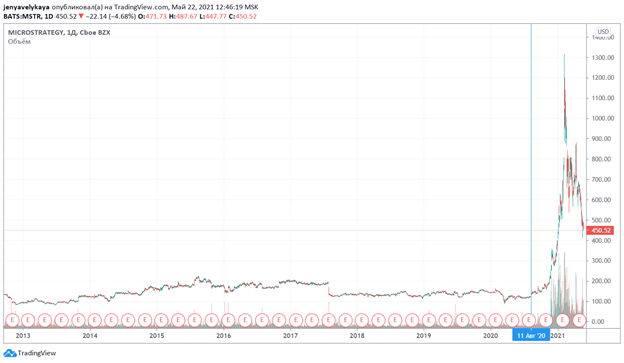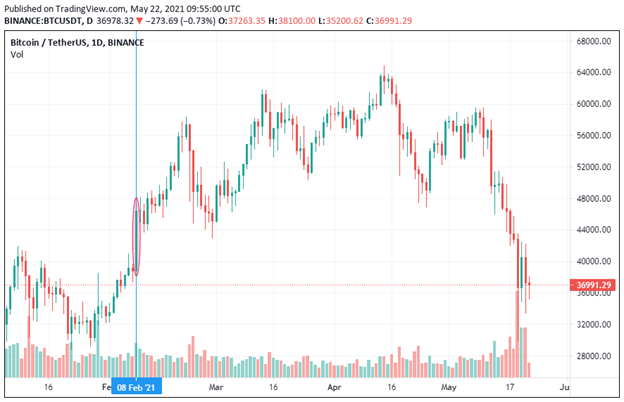Ye’s Crypto Coup: Did Kanye Se...
23 February 2025 | 8:30 pm
A couple of years ago, large companies considered it a good form to throw stones at the crypto industry, with Bitcoin and other popular cryptocurrencies coming under heavy criticism. Today, many market participants have been forced to radically alter their view of this new financial instrument and even join the crypto community.
What’s the reason for these big players’ change in attitude, and what organizations can be called major Bitcoin investors? Learn from our material!
Cryptocurrency has been around for just over 12 years. Of course, that’s nothing compared to traditional money, but despite their youth, cryptocurrencies are evolving much faster than classical financial instruments due to their technical features.
This rapid development has helped Bitcoin (BTC), the most capitalized of the digital assets, to pass through a number of important stages in just a few years. We suggest that you look at these in more detail.
The first block in the cryptocurrency network was generated on January 3, 2009. A couple of days later, on January 12, the creator of the coin, Satoshi Nakamoto, sent crypto enthusiast Hal Finney ten bitcoins.
Later, on October 5 of the same year, the New Liberty Standart exchange launched cryptocurrency trading. Prior to 2011, bitcoins were mined (coins were released from the network) and used for payment exclusively by crypto enthusiasts.
In 2011, a dark web marketplace called Silk Road began accepting Bitcoin. Sellers were attracted by cryptocurrency’s anonymity, which shielded their businesses from prosecution.
In many ways, it was thanks to Silk Road that Bitcoin gained fame as a financial tool for money laundering. Despite the shadow it cast on cryptocurrency, the dark web marketplace still helped popularize the project. As a result, Bitcoin entered a new stage of development.
Silk Road was eventually shut down under a cloud of scandal in 2013. That same year, Bitcoin broke through the $1 billion capitalization mark and entered a stage when it was touted as an alternative to fiat currency. From 2014 to 2017, many large companies began to organize means to accept bitcoins as payment.
Bitcoin gained even more momentum after the cryptocurrency’s halving (a halving of the level of rewards for mining) in 2016 and preparations were made to launch futures based on BTC. However, after peaking at $20,0000 in December of 2017, a crypto winter fell upon the market that lasted until the spring of 2019. This crisis helped drive many speculators and weak participants out of the market.
After peaking in December 2017, Bitcoin’s value suffered a long decline, which lasted until the summer of 2019, when it experienced a spurt of growth. This was followed by a prolonged correction that brought the cryptocurrency into a new phase of growth, which began at the end of 2020.
This was a period of positive movement similar to the one in 2017 that followed the halving. But, unlike the previous growth phase, Bitcoin was fully prepared for the new stage in 2020.
Firstly, cryptocurrency has already secured the status of an alternative financial instrument. This was facilitated by the coronavirus pandemic when many countries attempted to save their economies by printing new batches of currency and injecting them into their economies. This ‘quantitative easing’ was extensively practiced in the United States, for example.
An artificial increase in an economy’s money supply can negatively affect its currency’s value. Unlike dollars and other traditional currencies, the maximum issue of Bitcoin is limited – about 21 million bitcoins will be issued in all. At the same time, the rate of BTC issuance is constantly decreasing with the help of halvings, which makes it possible for Bitcoin to maintain and even increase its value.
With some countries opting to engage in quantitative easing, many market participants began to consider using BTC as a savings asset. This was clearly demonstrated when Americans began purchasing massive quantities of cryptocurrency with the government benefits they received during the coronavirus pandemic.
Secondly, many large companies have appeared on the market that supports the digital asset market in one way or another. In addition, accepting cryptocurrency as payment is no longer something out of the ordinary, and global cryptocurrency market capitalization has approached Apple’s.

Comparison of global cryptocurrency market capitalization with that of large companies, as of April 7, 2021.
Source: Twitter Coin98 Analytics
Thirdly, many market participants, including managers engaged in capital management, have become convinced of the stability of Bitcoin’s correction mechanisms. The fact is that each halving reduces the mining speed of already rare BTC, thereby creating a shortage of the asset on the market. The history of this cryptocurrency has shown that when this mechanism is employed, the price of Bitcoin rises. It is largely due to this that many companies have decided to invest in BTC.
In short, this is how Bitcoin went from being an unknown digital asset with a dubious reputation to a financial instrument with many large investors.
There are several companies in the market whose investments in BTC have had a significant impact on the cryptocurrency. Among them is an analytical software provider called MicroStrategy.
In August of 2020, the organization acquired 21,454 BTC, which was worth about $250 million at the time of the transaction. MicroStrategy became the first public company to invest part of its capital in Bitcoin. Subsequently, the organization has repeatedly announced increases in its investment in BTC.
One of MicroStrategy’s latest purchases fell on May 18, 2021, when Bitcoin’s price fell to $30,000 amid increasing regulatory pressure from China. According to the company’s CEO, Mike Saylor, MicroStrategy has accumulated a total of 92,079 BTC, taking into account the new purchase.
To see the impact of MicroStrategy’s decision to invest in Bitcoin, look carefully at this chart showing the history of the company’s share price. The blue vertical line marks the day it made its first BTC purchase:

MicroStrategy Stock Chart. Source: TradingView
Another company that has had a significant impact on Bitcoin’s position is Tesla. In early February of 2021, the electric car manufacturer reported to the US Securities and Exchange Commission (SEC) that it had made a purchase of cryptocurrency for $1.5 billion. The market’s reaction to Tesla’s decision can be seen on this BTC chart:

Bitcoin Chart. The blue vertical line marks the day of publication of Tesla’s report, which contains information on the company’s $1.5-billion purchase of BTC. The pink oval shows Bitcoin’s movement following the news release. (Source: TradingView)
Interesting fact! At the beginning of March 2021, analysts at Piplsay released a study that showed that about 40% of American investors are guided by Tesla founder Elon Musk’s Tweets when making investment decisions.
Given the faith that many market participants put in the developer, it’s not surprising that the cryptocurrency’s exchange rate soared after the announcement of the BTC purchase by his company’s representatives.
The decisions of MicroStrategy and Tesla to invest in the cryptocurrency have prompted many other organizations to quickly adjust their own investment strategies. Here are some examples:
It’s very likely that members of the crypto community will often hear about cryptocurrency purchases made by large companies in the future.
The fact that large companies have begun to invest in Bitcoin can be seen as a manifestation of trust in the new financial instrument, which makes it more attractive in the eyes of market participants. This change in the position of cryptocurrencies can be used to make a profit.
The last halving of Bitcoin took place in May of 2020. Many members of the crypto community believe that this digital asset will be able to break through the $100,000 mark within the current growth cycle. This possibility is confirmed by the projections of a BTC forecasting model developed by the popular analyst PlanB projects, which takes into account the speed of bitcoin mining, the influence of halvings, and the patterns of Bitcoin movement in previous periods.
PlanB is confident that the drop in BTC’s value seen at the end of May 2021 represents a great opportunity to buy Bitcoin at an attractive price.
#bitcoin oscilates in the dark blue band around S2F model value. Buying opportunities like today are rare (Q1 2019 when I wrote the S2F article, March 2020 due to covid, and now). Life is all about choices. https://t.co/rlb5dsIFSg pic.twitter.com/rQpTvzR3eW
— PlanB (@100trillionUSD) May 22, 2021
You can find many options for buying cryptocurrency with rubles on the web. Unfortunately, not all of them are worthy of attention. On many platforms, there’s a risk of encountering pitfalls: large commissions and inconvenient conditions included in the fine print.
At the same time, there are also many decent options on the market. For example, the fully Russified Alfacash platform allows you to profitably buy Bitcoin and other cryptocurrencies with rubles.
Unlike exchanges, you do not need to verify your account to work on the site. Registration only takes a few seconds, and you can start buying cryptocurrency immediately afterwards
Interesting! On Alfacash, among other things, you can buy digital assets with credit cards.
Alfacash also includes functions to exchange and sell digital assets, as well as other services that are necessary in order to comfortably work with these new financial instruments.
Image by Sharon McCutcheon from Pixabay